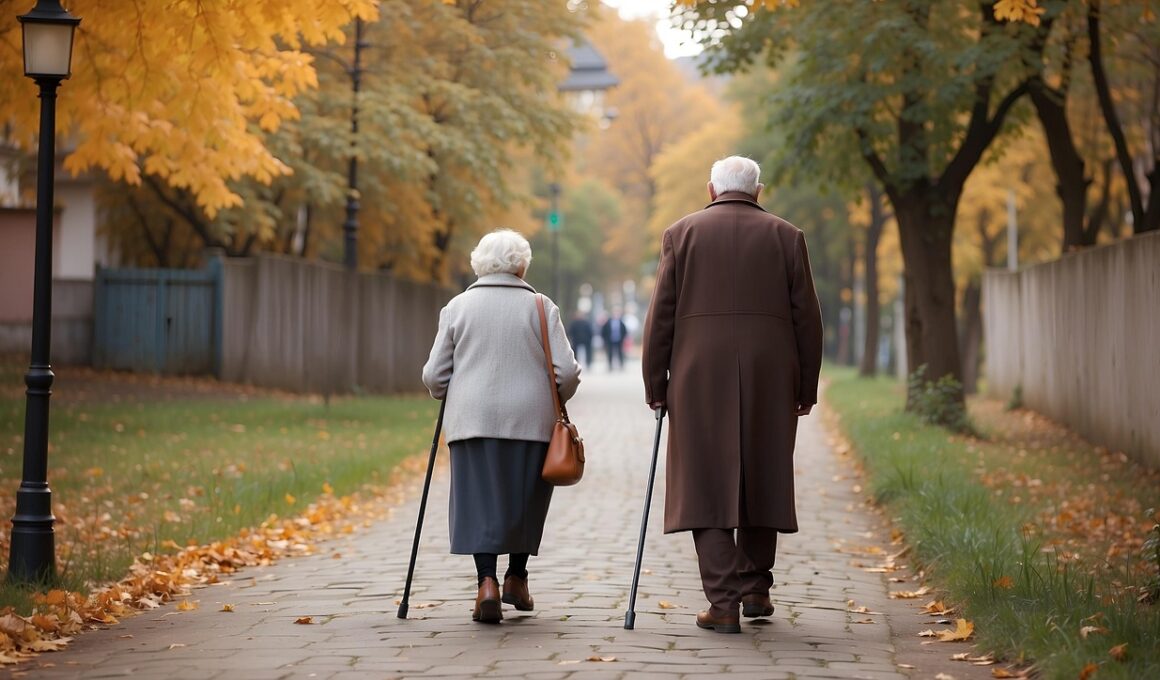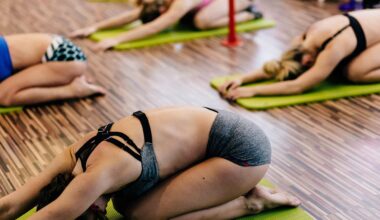Safe Bodyweight Workouts for Older Beginners
Bodyweight exercises offer an ideal way for older adults to engage in fitness without needing specialized equipment. Safety should always be the top priority for beginners. Warm-ups, such as gentle stretches and light mobility exercises, help prepare the body and reduce the risk of injury. Excellent bodyweight exercises include wall pushes, seated leg lifts, and modified squats to help build strength while maintaining balance. These exercises can be done at home, making them convenient for older individuals. Starting with low repetitions is crucial. Aim for one to three sets of five to ten repetitions, gradually increasing as strength improves. Remember to listen to your body and stop if any pain arises. Hydration is equally important during exercise. Drinking water before, during, and after workouts helps maintain energy levels. Additionally, breathing correctly can enhance performance: inhale during easier movements and exhale when exerting strength. Consistency is key to progress. Try to incorporate these safe exercises into your weekly routine for best results. Over time, benefits will become more noticeable, providing not just physical improvements but also mental rejuvenation.
Important Considerations for Older Adults
Older adults must consider their health conditions and fitness levels before starting bodyweight workouts. Consulting a healthcare professional ensures that chosen exercises are safe and appropriate given personal health factors such as arthritis or heart conditions. Modify exercises as needed to accommodate physical constraints. A chair can assist in strengthening exercises, such as sit-to-stands, allowing individuals to build up strength gradually. Additionally, focus on posture and alignment during exercises for safety and effectiveness. Move through each exercise slowly and deliberately, avoiding fast movements that may lead to falls or injuries. Pay attention to balance; exercises like standing calf raises or shoulder taps can further enhance stability. Breathing techniques play a vital role as well; breathe deeply throughout workouts to create optimal oxygen flow. Don’t hesitate to take breaks during workouts when fatigue arises. Finding a comfortable workout level is crucial to making fitness a sustainable part of daily life. Celebrating small achievements boosts motivation. Involving friends or family also enhances enjoyment, creating a supportive environment that encourages regular participation in safe bodyweight workouts.
Building a routine is essential for successful bodyweight exercise practices. Create a weekly schedule by setting aside specific days and times for workouts. This structure can help develop consistency, promoting long-term benefits. Start with shorter sessions, perhaps around fifteen to twenty minutes, gradually increasing duration as stamina builds. To keep things exciting, vary the exercises included in the routine. Introducing new movements can help prevent boredom while engaging different muscle groups. Adding elements like music or engaging fitness videos can further enhance enjoyment. Remember to incorporate warm-up and cool-down periods into workouts. These phases are crucial to prepare the body for exercise and to help recover afterward. After completing exercises, practice gentle stretching to alleviate any tightness or soreness. Explore various workout tips and successful routines through online resources or community classes targeted at older adults. Many programs, online platforms, and fitness communities cater specifically to seniors, providing tailored advice and support. This social aspect helps to foster motivation and compliance. Finding an enjoyable routine enables older adults to reap the benefits of bodyweight workouts while ensuring longevity in their fitness journeys.
Types of Bodyweight Exercises
A diverse range of bodyweight exercises can be practiced at home, making them quite accessible. Seated leg raises involve sitting on a sturdy chair and lifting one leg at a time, strengthening the hip flexors while improving core stability. Wall pushes replicate traditional push-ups but offer added support, making them a safer option for beginners. They can be performed by standing at arm’s length from a wall and pushing against it, activating the upper body without risking fall-related injuries. Modified squats increase leg strength: start by using a chair to help squat and stand up safely. Balance exercises, like standing on one leg, enhance stability while promoting muscle engagement in the lower body; older adults can hold onto a wall or chair for extra comfort. Planking on the knees improves core strength without exerting too much pressure on wrists. Performing gentle arm circles supports shoulder flexibility while alleviating tension. Aim to include a wide range of these exercises into weekly routines for holistic benefits. Each exercise not only engages physical aspects but also contributes to improved mood and cognitive functions.
Form is crucial when practicing bodyweight exercises, especially for older adults. Mistakes in technique can lead to injuries and impede progress. Focus on slow and controlled movements to maintain proper form and allow muscles to engage correctly. Starting exercises with a mirror near can help monitor alignment and posture. If possible, consider recording yourself during workouts to assess form and make necessary adjustments. Sharing these recordings with a fitness professional can yield personalized advice, enhancing your safety while exercising. It’s also recommended to work out in a distraction-free environment that supports concentration. Pick a space with good lighting and enough room to move comfortably, ensuring fixtures and furniture are out of the way to prevent accidents. Always be mindful of your personal limits; pushing too hard can lead to exhaustion and increased injury risk. Building strength and endurance takes time, so patience is vital. Celebrate achievements, however small, to keep morale high. Encourage friends or family members to participate in your exercise journey, as social interaction can enhance both motivation and enjoyment for optimal results in bodyweight fitness.
Integrated Nutrition for Better Results
Nutrition plays a vital role in supporting the physical fitness goals of older adults practicing bodyweight exercises. A balanced diet helps fuel workouts, enhances recovery, and boosts overall health. Prioritize protein intake, as it is essential for muscle repair and growth; lean meats, legumes, dairy, and plant-based sources are excellent options. Aim for a diverse range of fruits and vegetables to ensure adequate vitamins, minerals, and antioxidants. Whole grains like brown rice or quinoa provide energy while promoting digestive health through fiber. Maintaining proper hydration is crucial. Senior adults often require fewer fluids to realize thirst accurately; thus, awareness is key. Regularly drink water throughout the day to combat dehydration and support optimal performance during workouts. Additionally, moderation in meals is advantageous; avoid excessive consumption of high-calorie, low-nutrient foods to facilitate better energy management. Processed foods may lead to fatigue which impedes exercise routines. Seek out meal planning ideas tailored to individuals engaging in bodyweight exercises. Incorporating proper nutrition not only enhances workout performance but also contributes to improved overall wellness.
Lastly, staying motivated is instrumental for older adults engaging in bodyweight workouts. Setting realistic goals allows individuals to track their fitness journey effectively. Break larger goals into smaller, manageable milestones to maintain encouragement along the way. Celebrating achievements, no matter how minor, fosters a sense of accomplishment and drives motivation. Consider joining local community fitness classes or online forums tailored specifically for older adults. These platforms allow for social interaction and shared experiences that help maintain motivation in the long run. Pairing exercise with enjoyable activities can also enhance commitment; try listening to favorite music while working out or watching engaging television shows. Keep workout sessions flexible to fit your lifestyle, navigating busy schedules while remaining active. To prevent burnout or routine fatigue, change up exercises and activities frequently. Finally, remember that fitness isn’t solely about physical capability; the mental health benefits gained from regular exercise can also be profound. The sense of accomplishment can bolster self-esteem and promote resilience. With consistent effort and commitment, older beginners can enjoy a fulfilling journey toward improved health and fitness.


